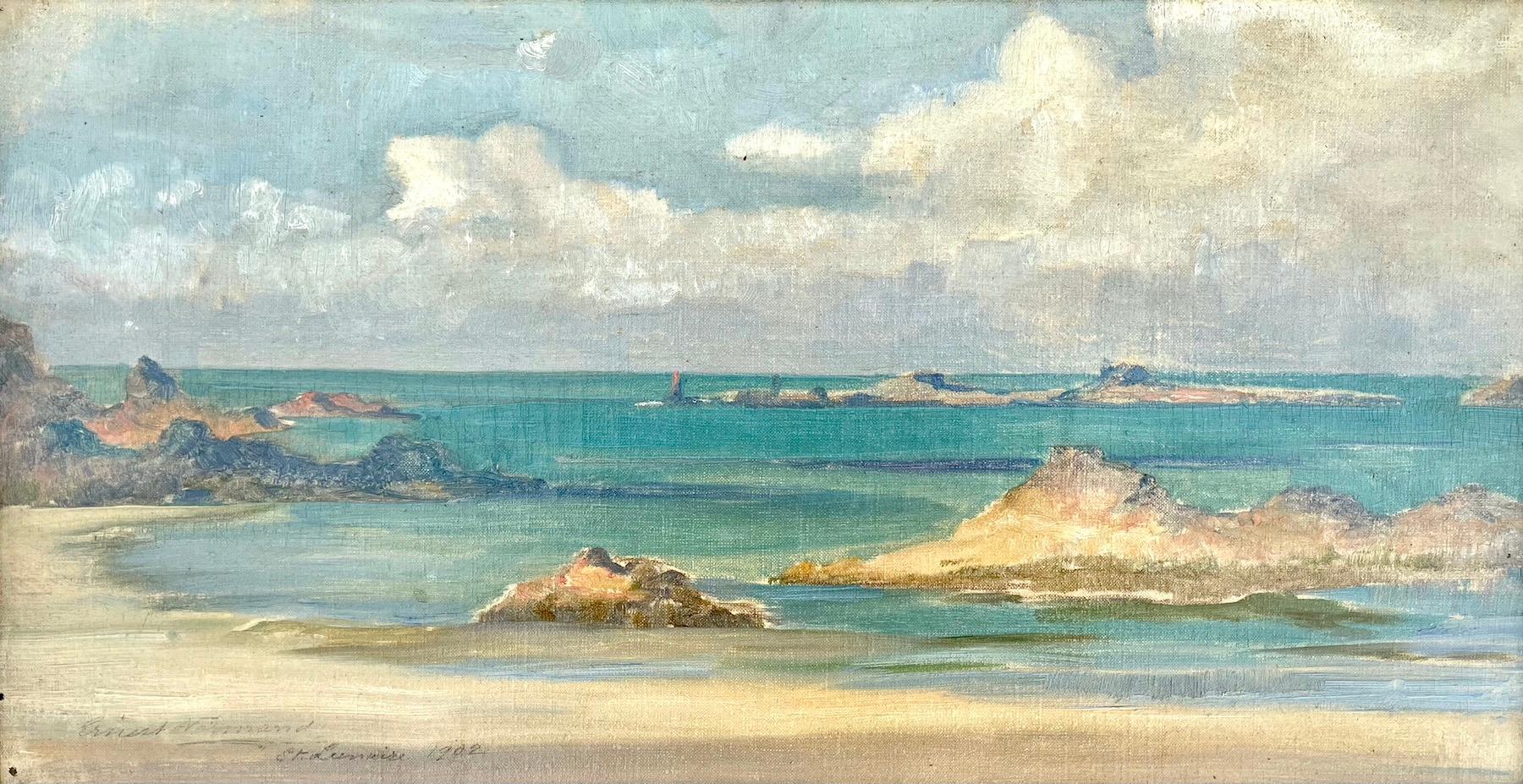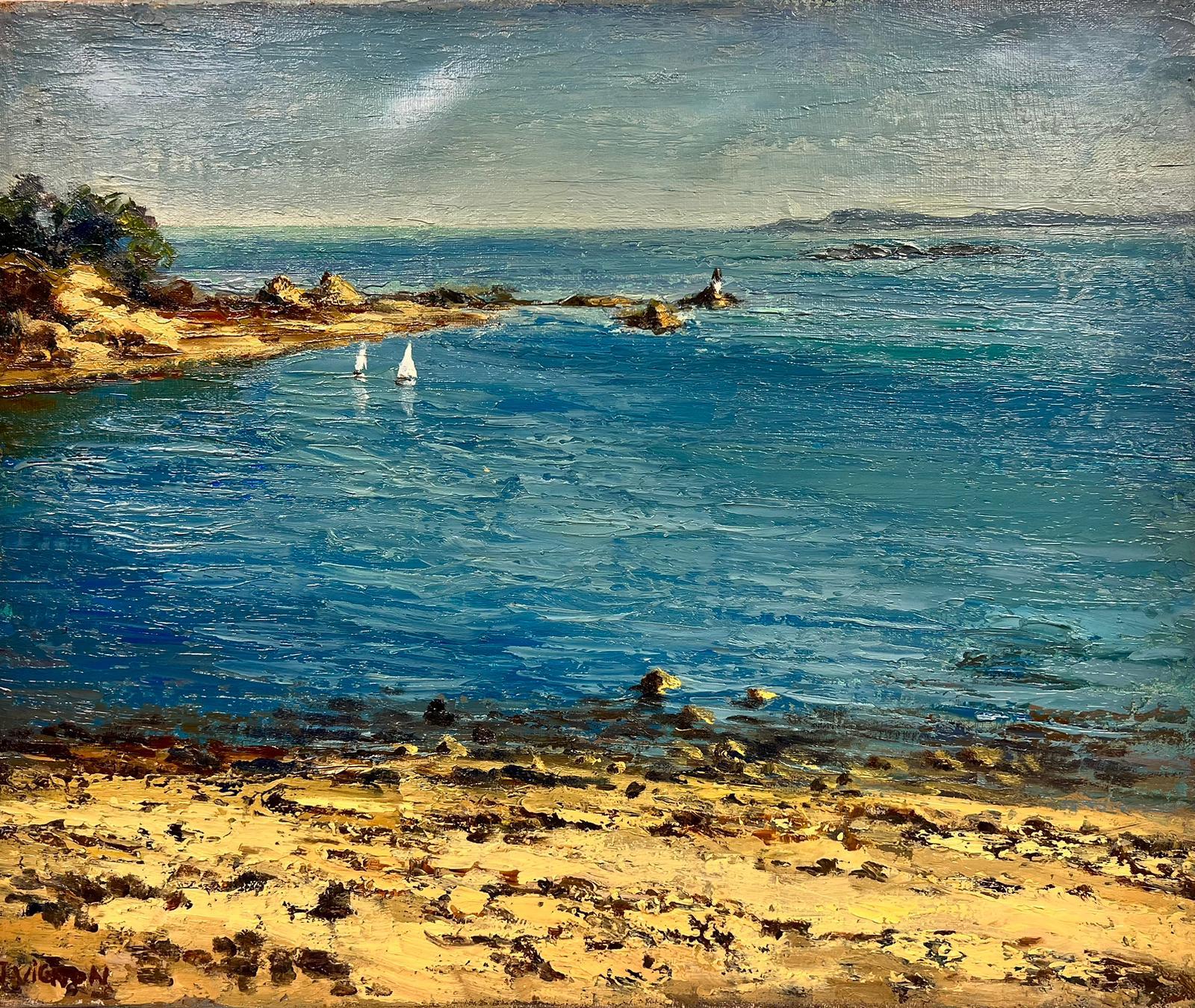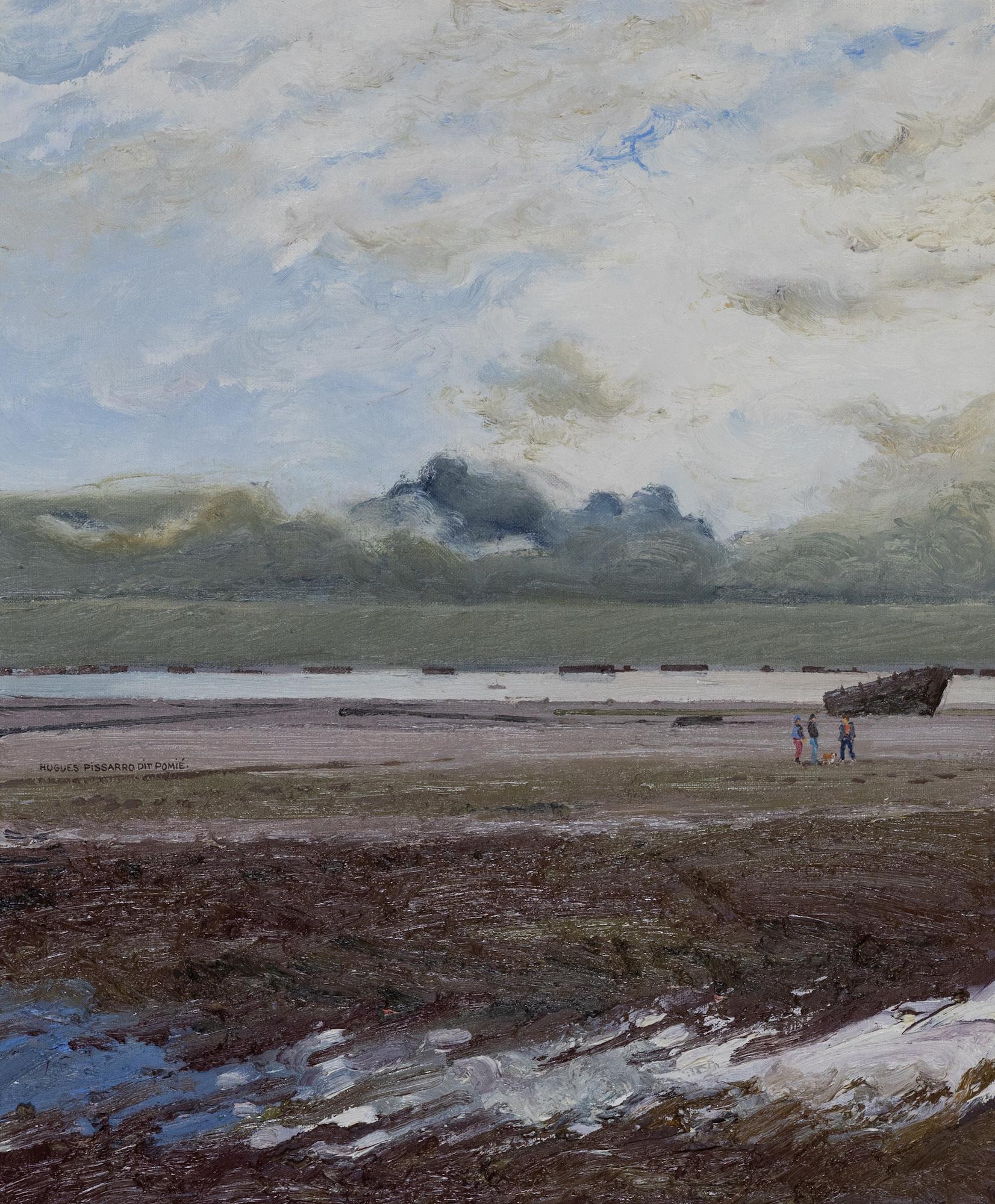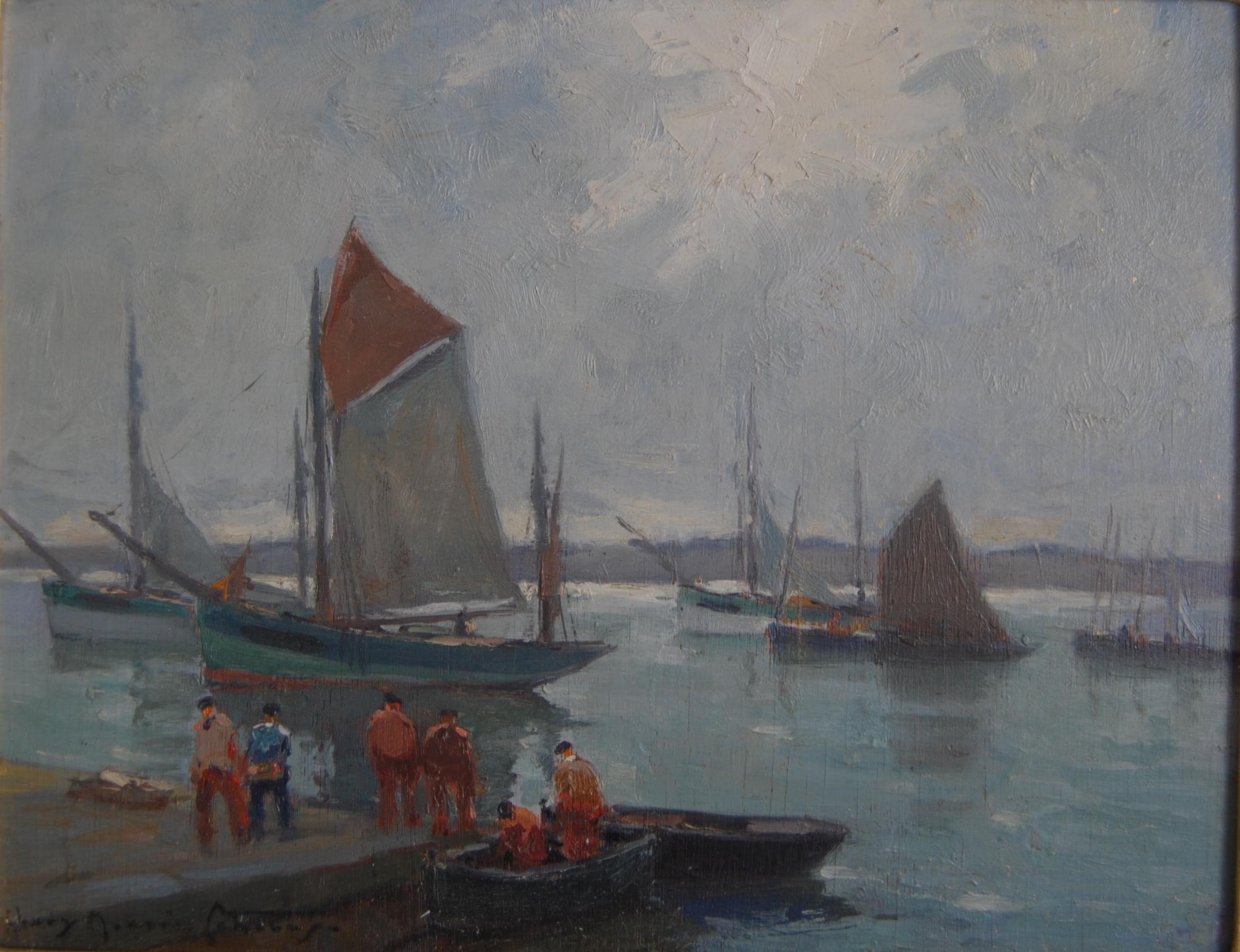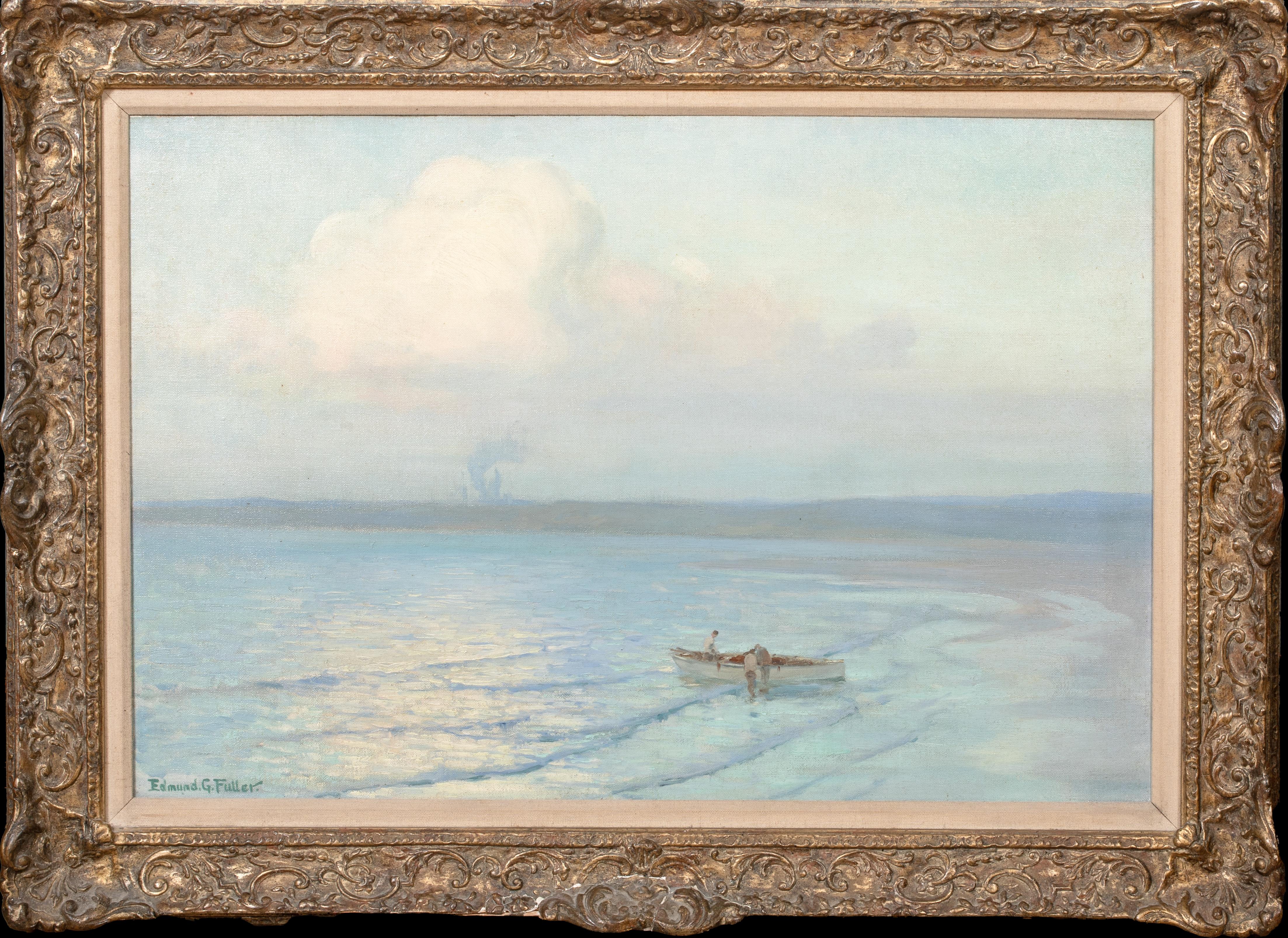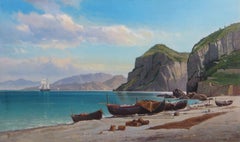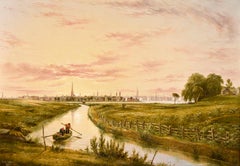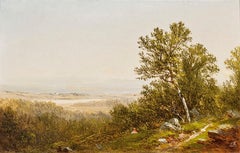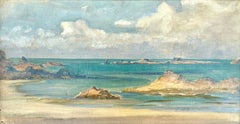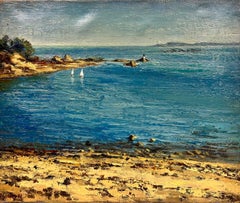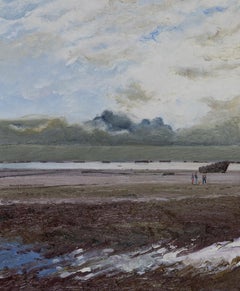Items Similar to Saint-Malo, Brittany
Want more images or videos?
Request additional images or videos from the seller
1 of 8
William Stanley HaseltineSaint-Malo, Brittany1868
1868
$110,000
£83,510.12
€95,517.77
CA$153,685.95
A$170,932.32
CHF 89,255.55
MX$2,080,064.58
NOK 1,139,929.56
SEK 1,069,052.82
DKK 712,885.70
Shipping
Retrieving quote...The 1stDibs Promise:
Authenticity Guarantee,
Money-Back Guarantee,
24-Hour Cancellation
About the Item
The career of William Stanley Haseltine spans the entire second half of the nineteenth century. During these years he witnessed the growth and decline of American landscape painting, the new concept of plein-air painting practiced by the Barbizon artists, and the revolutionary techniques of the French Impressionists, all of which had profound effects on the development of painting in the western world. Haseltine remained open to these new developments, selecting aspects of each and assimilating them into his work. What remained constant was his love of nature and his skill at rendering exactly what he saw. His views, at once precise and poetic, are, in effect, portraits of the many places he visited and the landscapes he loved.
Haseltine was born in Philadelphia, the son of a prosperous businessman. In 1850, at the age of fifteen, he began his art studies with Paul Weber, a German artist who had settled in Philadelphia two years earlier. From Weber, Haseltine learned about Romanticism and the meticulous draftsmanship that characterized the German School. At the same time, Haseltine enrolled at the University of Pennsylvania, and took sketching trips around the Pennsylvania countryside, exploring areas along the Delaware and Susquehanna rivers. Following his sophomore year, Haseltine transferred to Harvard University.
After graduating from Harvard in 1854, Haseltine returned to Philadelphia and resumed his studies with Weber. Although Weber encouraged Haseltine to continue his training in Europe, the elder Haseltine was reluctant to encourage his son to pursue a career as an artist. During the next year, Haseltine took various sketching trips along the Hudson River and produced a number of pictures, some of which were exhibited at the Pennsylvania Academy of the Fine Arts in the spring of 1855. Ultimately, having convinced his father that he should be allowed to study in Europe, Haseltine accompanied Weber to Düsseldorf.
The Düsseldorf Academy was, during the 1850s, at the peak of its popularity among American artists. The Academy’s strict course of study emphasized the importance of accurate draftsmanship and a strong sense of professionalism. Landscape painting was the dominant department at the Düsseldorf Academy during this period, and the most famous landscape painter there was Andreas Achenbach, under whom Haseltine studied. Achenbach’s realistic style stressed close observation of form and detail, and reinforced much of what Haseltine had already learned. His Düsseldorf training remained an important influence on him for the rest of his life.
At Düsseldorf, Haseltine became friendly with other American artists studying there, especially Emanuel Leutze, Worthington Whittredge, and Albert Bierstadt. They were constant companions, and in the spring and summer months took sketching trips together. In the summer of 1856 the group took a tour of the Rhine, Ahr, and Nahe valleys, continuing through the Swiss alps and over the Saint Gotthard Pass into northern Italy. The following summer Haseltine, Whittredge, and the painter John Irving returned to Switzerland and Italy, and this time continued on to Rome.
Rome was a fertile ground for artists at mid-century. When Haseltine arrived in the fall of 1857, the American sculptors Harriet Hosmer, Chauncey B. Ives, Joseph Mozier, William Henry Rinehart, and William Wetmore Story had flourishing studios. The poets, Robert and Elizabeth Barrett Browning, were in residence, and Nathaniel Hawthorne was at work on The Marble Faun. Like his fellow landscape painters, Haseltine was drawn to the Roman Campagna, where he executed numerous sketches of the ruins and the surrounding countryside. He also traveled south to Amalfi, Sorrento, and Capri.
After a two-year stay in Rome, Haseltine returned to America. He first set up a studio in Philadelphia, but by the fall of 1859 had moved to the Tenth Street Studio Building in New York, where Whittredge and Leutze also kept studios. Haseltine was active in the social and artistic life of the Tenth Street Studio Building, participating in studio receptions and receiving favorable, sometimes glowing, reviews of his work. He exhibited annually at the National Academy of Design, where he was elected an associate in 1860, and a full academician in 1861. His work was also included in the annual exhibitions at the Pennsylvania Academy of the Fine Arts and the Boston Athenaeum. Initially, Haseltine showed works based on his European sketches. Then, as he accumulated sketches from trips along the Delaware and the coasts of New Hampshire, Maine, Rhode Island, and Massachusetts, he began to send paintings of American subjects to the exhibitions.
Haseltine spent the summer of 1862 sketching along the New England coast, stopping along the way in Narragansett, Rhode Island. The rocky coast there must have made an enormous impression on him, for the following March he submitted three Narragansett paintings to the Brooklyn Art Association and two in April to the National Academy of Design. While his European and other American subjects continued to appear in exhibitions, his paintings of the coastlines of Rhode Island and especially Nahant, Massachusetts, what Henry Tuckerman termed his “rock-portraits” (Book of the Artists [1867], p. 557), were considered his greatest successes. Haseltine’s concern for accurate geological detail reflected the pervasive influence of the Pre-Raphaelite movement during these years. Indeed, his luminist coastal views of the 1860s parallel the work of William Trost Richards, one of the most devoted practitioners of the Pre-Raphaelite style. Coincidentally, Richards had also studied under Paul Weber in Philadelphia, and his landscapes exhibit a similar concern with meticulous detail and atmospheric effects.
In 1860, Haseltine married Helen Lane. She died giving birth to their second child in 1864. In 1866, Haseltine married his late wife’s best friend, Helen Marshall, the daughter of Captain Charles Henry Marshall, who had been a part owner of the Black Ball Steamship Line. In the spring of 1866, the family returned to Europe, where Haseltine set up a studio on the Boulevard de Clichy in Paris. Shortly thereafter he began traveling in search of subjects for his painting, spending time in Rome, Naples, Sicily, and Paris. By the fall of 1868, Haseltine was back in Rome, where he took a studio in the same building as Frederic Edwin Church and Jervis McEntee. Many other American artists were also in Rome at the time, including Sanford Robinson Gifford, whom Haseltine had met during his student years while travelling through Switzerland, and George P. A. Healy, who painted the Haseltines’ portraits. In the spring of 1869 Haseltine traveled to the United States with his eldest son, Stanley, but returned to Europe, where the family settled permanently in Rome.
The Haseltine home in Rome, first in the Palazzo Carcano, then in the Palazzo Altieri, then became a popular meeting place for an international group of artists, writers, diplomats, and other notables, a social and cultural milieu of wealth, talent and intellect. As Haseltine’s fame grew, orders for pictures flowed in from influential patrons around the world, including J. P. Morgan, John Cabot Lodge, the Duke of Nassau, and the King of Denmark, all of whom requested Italian views. Throughout the 1870s and 1880s, Haseltine traveled every summer throughout Europe or the United States in search of new material.
In the late 1880s and 1890s the Haseltine family spent summers in Traunstein, Bavaria. Haseltine returned to America frequently during the 1890s, in 1893 to visit the World’s Columbian Exposition at Chicago and to enroll his son Herbert in school in Connecticut, and, later, to help Herbert settle in at Harvard. In 1899 father and son took a trip West, visiting California, Washington, Oregon, Alaska, Banff, and Yellowstone.
When Haseltine returned to Rome that fall, he began work on a new painting, but it was never finished. He was struck with pneumonia just after the New Year, and he died within a few days. Obituary notices that listed his most famous works consistently mentioned his New England rock paintings and his Italian views, subjects for which he is still best known today.
William Stanley Haseltine’s peripatetic life gave him first-hand knowledge of the various artistic movements that developed in America and Europe between 1850, the year he began his training, and 1900, the year of his death. His art reflected his independence: he never aligned himself with any school, nor did he limit himself to a particular dogma. He had a Luminist’s sense of light and atmosphere, a Pre-Raphaelite’s fascination with natural detail, a Romantic’s love of scenic landscapes, and an Impressionist’s understanding of light and color. With skill and insight, he was able to capture the essence of a place, wherever he was. Whether in the clear, sparkling light of the New England coast, the cool haziness of the Low Countries, or the brilliant sun of the Mediterranean, Haseltine created exacting, yet expressive portraits of nature in the Old World and the New.
Haseltine traveled extensively throughout the first half of 1868, departing from Rome variously to Tivoli, Naples, Palermo, Capri, Ischia, Milan, Geneva, Paris, and Switzerland, all by the end of June. In July he decided to stay put for at least a short while, spending nearly a month with his family at the walled city of Saint-Malo, which lies in Brittany along the coast of the English Channel. Saint-Malo sits at the mouth of the Rance River and its estuary, and today is the most visited site in Brittany. It was a popular destination for artists, too; among the many Americans who painted the city were Daniel Ridgway Knight, Frank Meyers Boggs, Robert Swain Gifford, Conrad Wise Chapman, and especially Maurice Prendergast, who executed dozens of paintings Saint-Malo and the surrounding area. Saint-Malo, too, is very close to the small fishing village of Cancale, which John Singer Sargent famously memorialized in his iconic The Oyster Gatherers of Cancale (1878, Corcoran Gallery of Art, Washington, D.C.). Haseltine sketched and painted Saint-Malo’s environs in his own characteristic manner, focusing mostly on the details of the rocky and silted coast and the fleeting reflections off the blue waters of the estuary, and showing considerably less interest in Saint-Malo itself, which can be seen across the water. At a glance this painting could just as easily be one of Haseltine’s more celebrated canvases of Nahant but for the walled city and church spire that rises in the distance. The same is true for a related painting by Haseltine, Saint Malo, Brittany (about 1868, private collection; see Marc Simpson et al., Expressions of Place: The Art of William Stanley Haseltine, exhib. cat. [San Francisco: The Fine Arts Museums of San Francisco, M. H. de Young Memorial Museum, 1992], p. 111 no. 37 illus. in color), which shows the opposite side of the city from a position at a similar distance as the present painting.
- Creator:William Stanley Haseltine (1835-1900, American)
- Creation Year:1868
- Dimensions:Height: 14 in (35.56 cm)Width: 22.5 in (57.15 cm)
- Medium:
- Movement & Style:
- Period:
- Condition:
- Gallery Location:New York, NY
- Reference Number:Seller: APG 85441stDibs: LU234875141
About the Seller
5.0
Recognized Seller
These prestigious sellers are industry leaders and represent the highest echelon for item quality and design.
Established in 1952
1stDibs seller since 2010
35 sales on 1stDibs
Typical response time: 3 hours
Associations
Art Dealers Association of America
- ShippingRetrieving quote...Shipping from: New York, NY
- Return Policy
Authenticity Guarantee
In the unlikely event there’s an issue with an item’s authenticity, contact us within 1 year for a full refund. DetailsMoney-Back Guarantee
If your item is not as described, is damaged in transit, or does not arrive, contact us within 7 days for a full refund. Details24-Hour Cancellation
You have a 24-hour grace period in which to reconsider your purchase, with no questions asked.Vetted Professional Sellers
Our world-class sellers must adhere to strict standards for service and quality, maintaining the integrity of our listings.Price-Match Guarantee
If you find that a seller listed the same item for a lower price elsewhere, we’ll match it.Trusted Global Delivery
Our best-in-class carrier network provides specialized shipping options worldwide, including custom delivery.More From This Seller
View AllMarina Grande, Capri
By Charles Temple Dix
Located in New York, NY
Charles Temple Dix was born in Albany, New York, the youngest son of the distinguished statesman and soldier, General John Adams Dix. Having already visited Europe as a child, Dix re...
Category
19th Century American Realist Landscape Paintings
Materials
Canvas, Oil
Fishing Camp on the Labrador Coast
By William Bradford
Located in New York, NY
In 1852, twenty-nine year old William Bradford was a failing shopkeeper in Fairhaven, Massachusetts. With a wife and child at home, Bradford, by his own admission, “spent too much time in painting to succeed” in business. Rescued from insolvency by his well-to-do in-laws, this is not the beginning of a narrative that generally leads to a happy ending. Not so with Bradford, who ultimately found international fame and fortune as a painter of arctic seascapes and dramatic marine paintings.
William Bradford, the artist, was a lineal descendant of the 17th-century Separatist leader William Bradford, a founder of the Plymouth Plantation, signer of the Mayflower Compact and Governor of the Plymouth Colony. Our Bradford born to a New Bedford ship outfitter in Fairhaven, Massachusetts By the nineteenth century, this line of Bradfords were Quakers, living on the tract purchased nearly two centuries earlier by their pilgrim ancestor. Fairhaven, across the mouth of the Acushnet River from the whaling center of New Bedford was described by a New York journalist in 1857 as “the Brooklyn of New Bedford” (Home Journal, January 3, 1857). Young Bradford displayed an early predilection for the arts, but his Quaker parents were disinclined to support this particular pursuit. After working in his father’s business and then for a dry goods merchant in New Bedford, by 1849 Bradford had set up in New Bedford as a “merchant tailor” offering outfits for “those going to California,” “seamen’s clothing,” custom-tailored “piece goods...
Category
19th Century American Realist Landscape Paintings
Materials
Canvas, Paper, Oil
New York from Hoboken
By William Rickarby Miller
Located in New York, NY
Signed (at lower left): W.R. Miller/ 1851
Category
Mid-19th Century American Realist Landscape Paintings
Materials
Canvas, Oil
Figure in a Landscape
By David Johnson
Located in New York, NY
Signed (at lower right): DJ [monogram]; (on back): David Johnson 1865
Category
Mid-19th Century American Realist Landscape Paintings
Materials
Oil, Board
Hemlock--Selden's Neck, Lyme, Connecticut
By Charles De Wolf Brownell
Located in New York, NY
Framed, 5.25 x 8.5 x 1.5 in.
Category
19th Century American Realist Landscape Drawings and Watercolors
Materials
Watercolor
A Specific View (SCIENTIA, ARTE, VENUSTAS) (Knowledge, Skill, Beauty)
By David Ligare
Located in New York, NY
Signed and dated (on verso): D. Ligare / 2024
Category
2010s Contemporary Landscape Paintings
Materials
Canvas, Oil
You May Also Like
St Lunaire, Brittany - Early 20th Century British landscape by Ernest Normand
By Ernest Normand
Located in London, GB
ERNEST NORMAND
(1857-1923)
St Lunaire, Brittany
Signed, inscribed and dated l.l.: Ernest Normand/St Lunaire 1902
Oil on canvas
Framed
26 by 49 cm., 10 ¼ by 19 ¼ in.
(frame size 38 by 61 cm., 15 by 24 in.)
Ernest Normand was born in London and studied at the Royal Academy Schools. He is best known as a painter of history and orientalist paintings and portrait commission. In 1884 he married the painter and writer Henrietta Rae. They lived in Holland Park and were part of that area’s artistic group which included Leighton, Millais, Prinsep and Watts. In the 1890s they travelled of Paris to study at the Academie Julian with Jules Joseph Lefebvre and Jean-Joseph Benjamin-Constant. He exhibited at the Royal Academy and works by him are in the collections of Glasgow Museum...
Category
Early 1900s Realist Landscape Paintings
Materials
Oil
Blue Seas Of The South Coast Brittany French Post Impressionist Signed Oil
By Josine Vignon
Located in Cirencester, Gloucestershire
Brittany
by Josine Vignon (French 1922-2022)
signed on front and back
oil painting on canvas, unframed
canvas: 15 x 18 inches
Colors: Blue colors, beige, brown, green and white
Ve...
Category
Mid-20th Century Post-Impressionist Landscape Paintings
Materials
Canvas, Oil
"Low Tide - Brittany, France, " Henriette Oberteuffer, Coastal Landscape
By Henriette Amiard Oberteuffer
Located in New York, NY
Henriette Amiard Oberteuffer (1878 - 1962)
Low Tide - Brittany, France
Oil on canvasboard
18 x 21 1/2 inches
Signed lower right
Painter, printmaker, and teacher Henriette Amiard Oberteuffer (1878-1962) was born in Le Havre, France and studied at the Academie Julian in Paris with Jean-Paul Laurens and Benjamin Constant. She moved with her husband and fellow artist George Oberteuffer...
Category
Early 20th Century American Impressionist Landscape Paintings
Materials
Oil, Board
Marée Basse - Arromanches by Hugues Pissarro dit Pomié - Landscape painting
By Hughes Claude Pissarro
Located in London, GB
*UK BUYERS WILL PAY AN ADDITIONAL 20% VAT ON TOP OF THE ABOVE PRICE
Marée Basse - Arromanches by Hugues Pissarro dit Pomié (b. 1935)
Oil on canvas
65 x 54 cm (2 5⅝ x 21 ¼ inches)
Si...
Category
Early 2000s Contemporary Figurative Paintings
Materials
Canvas, Oil
French Post Impressionist Breton school Oil Painting of Harbour, Douarnenez
By Henry Maurice CAHOURS
Located in ludlow, GB
French Post Impressionist Oil Painting of Breton Fishermen and Boats in the Harbour at Douarnenez.
A perfect study in post impressionism both in subject matter and technique. Cahour...
Category
Early 20th Century Post-Impressionist Landscape Paintings
Materials
Oil
Hayle, Cornwall, 19th Century by EDMUND FULLER (1858-1944)
Located in Blackwater, GB
Hayle, Cornwall, 19th Century
by EDMUND FULLER (1858-1944) sales to $10,000
Large 19th Century view of Halle, Cornwall, oil on canvas by Edmund Fuller. Excellent quality panoramic ...
Category
19th Century Landscape Paintings
Materials
Canvas, Oil
$3,741 Sale Price
35% Off
More Ways To Browse
Antique Brittany
Old Danish Paintings
Landscape Mid Century Danish
Danish Painting 19th Century
J King Paintings
Danish Paintings Of The 19th Century
19th Cat Painting
Paintings Pre 1900
19th Century Robinson
Stanley Antique
Gifford John
Art Antique Pre 1900 Paintings
Roman Marble Portrait
1850 Portrait American
Oysters Still Life
Dior Pre Fall
Oyster Wall Art
Steamship Paintings
